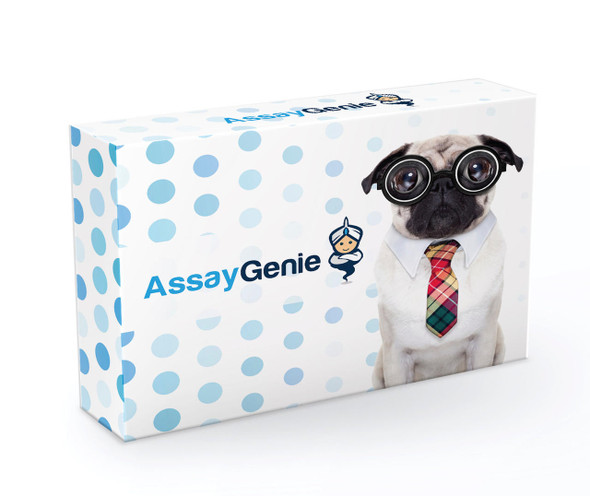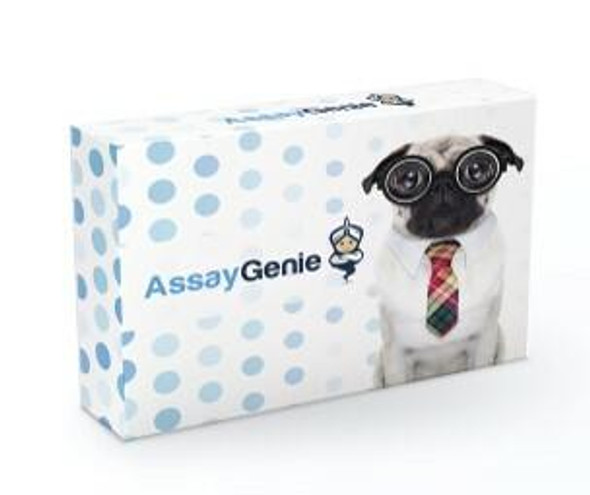Description
Mouse Leptin ELISA Kit
The Mouse Leptin ELISA Kit is specifically designed for the precise measurement of leptin levels in mouse serum, plasma, and tissue culture supernatants. This kit is known for its exceptional sensitivity and specificity, guaranteeing consistent and accurate results, making it a valuable tool for various research purposes.Leptin is a hormone that plays a vital role in regulating energy balance and body weight. It is involved in appetite control, metabolism, and obesity, making it a key target for studying metabolic disorders and related diseases.
Using the Mouse Leptin ELISA Kit can provide valuable insights into leptin levels in experimental models, contributing to a better understanding of metabolic pathways and potential therapeutic interventions.Overall, the Mouse Leptin ELISA Kit is a valuable asset for researchers studying metabolic disorders, obesity, and related conditions in mouse models. Its high-quality performance and reliability make it an essential tool for any laboratory focusing on leptin research.
| Product Name: | Mouse Leptin ELISA Kit |
| Product Code: | MOFI00070 |
| Size: | 96 Assays |
| Alias: | Leptin, LEP, LEPD, OBS, Obesity Homolog |
| Detection Method: | Sandwich ELISA |
| Application: | This immunoassay kit allows for the in vitro quantitative determination of Mouse Leptin concentrations in serum plasma and other biological fluids. |
| Sensitivity: | 37.5pg/ml |
| Range: | 62.5-4000pg/ml |
| Storage: | 4°C for 6 months |
| Note: | For Research Use Only |
| Recovery: | Matrices listed below were spiked with certain level of Mouse Leptin and the recovery rates were calculated by comparing the measured value to the expected amount of Mouse Leptin in samples. | ||||||||||||||||
| |||||||||||||||||
| Linearity: | The linearity of the kit was assayed by testing samples spiked with appropriate concentration of Mouse Leptin and their serial dilutions. The results were demonstrated by the percentage of calculated concentration to the expected. | ||||||||||||||||
| |||||||||||||||||
| Intra Assay: | CV <8% | ||||||||||||||||
| Inter Assay: | CV <10% |
| Component | Quantity | Storage |
| ELISA Microplate (Dismountable) | 8×12 strips | 4°C for 6 months |
| Lyophilized Standard | 2 | 4°C/-20°C |
| Sample/Standard Dilution Buffer | 20ml | 4°C |
| Biotin-labeled Antibody(Concentrated) | 120ul | 4°C (Protect from light) |
| Antibody Dilution Buffer | 10ml | 4°C |
| HRP-Streptavidin Conjugate(SABC) | 120ul | 4°C (Protect from light) |
| SABC Dilution Buffer | 10ml | 4°C |
| TMB Substrate | 10ml | 4°C (Protect from light) |
| Stop Solution | 10ml | 4°C |
| Wash Buffer(25X) | 30ml | 4°C |
| Plate Sealer | 5 | - |
Other materials and equipment required:
- Microplate reader with 450 nm wavelength filter
- Multichannel Pipette, Pipette, microcentrifuge tubes and disposable pipette tips
- Incubator
- Deionized or distilled water
- Absorbent paper
- Buffer resevoir
| Uniprot | P41160 |
| UniProt Protein Function: | leptin: May function as part of a signaling pathway that acts to regulate the size of the body fat depot. An increase in the level of LEP may act directly or indirectly on the CNS to inhibit food intake and/or regulate energy expenditure as part of a homeostatic mechanism to maintain constancy of the adipose mass. Defects in LEP may be a cause of obesity (OBESITY). It is a condition characterized by an increase of body weight beyond the limitation of skeletal and physical requirements, as the result of excessive accumulation of body fat. Belongs to the leptin family. |
| UniProt Protein Details: | Protein type:Secreted, signal peptide; Secreted; Hormone; Cell development/differentiation Cellular Component: extracellular space; cell; cytoplasm; extracellular region; intracellular Molecular Function:protein binding; growth factor activity; peptide hormone receptor binding; hormone activity Biological Process: response to dietary excess; positive regulation of myeloid cell differentiation; regulation of fat cell differentiation; positive regulation of JAK-STAT cascade; regulation of steroid biosynthetic process; negative regulation of transcription from RNA polymerase II promoter; signal transduction; glucose homeostasis; negative regulation of metabolic process; negative regulation of appetite; response to insulin stimulus; positive regulation of tyrosine phosphorylation of Stat3 protein; positive regulation of MAPKKK cascade; regulation of cholesterol absorption; regulation of blood pressure; positive regulation of cell proliferation; positive regulation of ion transport; regulation of metabolic process; central nervous system neuron development; placenta development; cholesterol metabolic process; regulation of protein amino acid phosphorylation; positive regulation of developmental growth; eating behavior; bile acid metabolic process; glucose metabolic process; adult feeding behavior; fatty acid catabolic process; ovulation from ovarian follicle; leptin-mediated signaling pathway; negative regulation of vasoconstriction; tyrosine phosphorylation of STAT protein; fatty acid beta-oxidation; positive regulation of protein import into nucleus; insulin secretion; glycerol biosynthetic process; energy reserve metabolic process; hormone metabolic process; regulation of gluconeogenesis; lipid metabolic process; positive regulation of insulin receptor signaling pathway; leukocyte tethering or rolling; regulation of insulin secretion; negative regulation of apoptosis |
| UniProt Code: | P41160 |
| NCBI GenInfo Identifier: | 730219 |
| NCBI Gene ID: | 16846 |
| NCBI Accession: | P41160.1 |
| UniProt Related Accession: | P41160 |
| Molecular Weight: | 18,709 Da |
| NCBI Full Name: | Leptin |
| NCBI Synonym Full Names: | leptin |
| NCBI Official Symbol: | Lep |
| NCBI Official Synonym Symbols: | ob; obese |
| NCBI Protein Information: | leptin; obesity factor |
| UniProt Protein Name: | Leptin |
| UniProt Synonym Protein Names: | Obesity factor |
| Protein Family: | Leptin |
| UniProt Gene Name: | Lep |
| UniProt Entry Name: | LEP_MOUSE |
*Note: Protocols are specific to each batch/lot. For the correct instructions please follow the protocol included in your kit.
| Step | Procedure |
| 1. | Set standard, test sample and control (zero) wells on the pre-coated plate respectively, and then, record their positions. It is recommended to measure each standard and sample in duplicate. Wash plate 2 times before adding standard, sample and control (zero) wells! |
| 2. | Aliquot 0.1ml standard solutions into the standard wells. |
| 3. | Add 0.1 ml of Sample / Standard dilution buffer into the control (zero) well. |
| 4. | Add 0.1 ml of properly diluted sample (Human serum, plasma, tissue homogenates and other biological fluids.) into test sample wells. |
| 5. | Seal the plate with a cover and incubate at 37 °C for 90 min. |
| 6. | Remove the cover and discard the plate content, clap the plate on the absorbent filter papers or other absorbent material. Do NOT let the wells completely dry at any time. Wash plate X2. |
| 7. | Add 0.1 ml of Biotin- detection antibody working solution into the above wells (standard, test sample & zero wells). Add the solution at the bottom of each well without touching the side wall. |
| 8. | Seal the plate with a cover and incubate at 37°C for 60 min. |
| 9. | Remove the cover, and wash plate 3 times with Wash buffer. Let wash buffer rest in wells for 1 min between each wash. |
| 10. | Add 0.1 ml of SABC working solution into each well, cover the plate and incubate at 37°C for 30 min. |
| 11. | Remove the cover and wash plate 5 times with Wash buffer, and each time let the wash buffer stay in the wells for 1-2 min. |
| 12. | Add 90 µL of TMB substrate into each well, cover the plate and incubate at 37°C in dark within 10-20 min. (Note: This incubation time is for reference use only, the optimal time should be determined by end user.) And the shades of blue can be seen in the first 3-4 wells (with most concentrated standard solutions), the other wells show no obvious color. |
| 13. | Add 50 µL of Stop solution into each well and mix thoroughly. The color changes into yellow immediately. |
| 14. | Read the O.D. absorbance at 450 nm in a microplate reader immediately after adding the stop solution. |
When carrying out an ELISA assay it is important to prepare your samples in order to achieve the best possible results. Below we have a list of procedures for the preparation of samples for different sample types.
| Sample Type | Protocol |
| Serum: | If using serum separator tubes, allow samples to clot for 30 minutes at room temperature. Centrifuge for 10 minutes at 1,000x g. Collect the serum fraction and assay promptly or aliquot and store the samples at -80°C. Avoid multiple freeze-thaw cycles. If serum separator tubes are not being used, allow samples to clot overnight at 2-8°C. Centrifuge for 10 minutes at 1,000x g. Remove serum and assay promptly or aliquot and store the samples at -80°C. Avoid multiple freeze-thaw cycles. |
| Plasma: | Collect plasma using EDTA or heparin as an anticoagulant. Centrifuge samples at 4°C for 15 mins at 1000 × g within 30 mins of collection. Collect the plasma fraction and assay promptly or aliquot and store the samples at -80°C. Avoid multiple freeze-thaw cycles. Note: Over haemolysed samples are not suitable for use with this kit. |
| Urine & Cerebrospinal Fluid: | Collect the urine (mid-stream) in a sterile container, centrifuge for 20 mins at 2000-3000 rpm. Remove supernatant and assay immediately. If any precipitation is detected, repeat the centrifugation step. A similar protocol can be used for cerebrospinal fluid. |
| Cell culture supernatant: | Collect the cell culture media by pipette, followed by centrifugation at 4°C for 20 mins at 1500 rpm. Collect the clear supernatant and assay immediately. |
| Cell lysates: | Solubilize cells in lysis buffer and allow to sit on ice for 30 minutes. Centrifuge tubes at 14,000 x g for 5 minutes to remove insoluble material. Aliquot the supernatant into a new tube and discard the remaining whole cell extract. Quantify total protein concentration using a total protein assay. Assay immediately or aliquot and store at ≤ -20°C. |
| Tissue homogenates: | The preparation of tissue homogenates will vary depending upon tissue type. Rinse tissue with 1X PBS to remove excess blood & homogenize in 20ml of 1X PBS (including protease inhibitors) and store overnight at ≤ -20°C. Two freeze-thaw cycles are required to break the cell membranes. To further disrupt the cell membranes you can sonicate the samples. Centrifuge homogenates for 5 mins at 5000xg. Remove the supernatant and assay immediately or aliquot and store at -20°C or -80°C. |
| Tissue lysates: | Rinse tissue with PBS, cut into 1-2 mm pieces, and homogenize with a tissue homogenizer in PBS. Add an equal volume of RIPA buffer containing protease inhibitors and lyse tissues at room temperature for 30 minutes with gentle agitation. Centrifuge to remove debris. Quantify total protein concentration using a total protein assay. Assay immediately or aliquot and store at ≤ -20 °C. |
| Breast Milk: | Collect milk samples and centrifuge at 10,000 x g for 60 min at 4°C. Aliquot the supernatant and assay. For long term use, store samples at -80°C. Minimize freeze/thaw cycles. |
| Saurabh Kadyan et al. | Resistant starches from dietary pulses improve neurocognitive health via gut-microbiome-brain axis in aged mice | Frontiers in Nutrition 2024 | PubMed ID: 38352704 |






